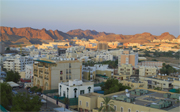 There is reason to be optimistic about investment into Oman, but the country will be among the worst affected in the Gulf if oil prices stay low, writes George Mitton.
There is reason to be optimistic about investment into Oman, but the country will be among the worst affected in the Gulf if oil prices stay low, writes George Mitton.
The likes of Saudi Arabia and Kuwait are sitting on huge cash reserves that will tide them over (they hope) until oil prices rise again, but middle-income Oman, which has far less money in the bank, might find its budget thrown out of balance.
So how precarious is Oman’s situation? According to the country’s 2015 budget plan, Oman will raise government spending this year to 14.1 billion rials ($36.6 billion). Unfortunately, government revenues for 2015 were projected in the budget to be 11.6 billion rials, leaving a deficit of 2.5 billion rials.
More worrying still, the country’s minister for financial affairs, Darwish al-Balushi, was reported as saying the budget assumes an average Brent crude price of $75 over the year. Some analysts think it will be less than that. Goldman Sachs, for example, put out a research note that predicted the oil price would average just $50 this year.
Not everyone is concerned. Abdullah Al Hinai, deputy general manager of investment banking and financial institutions at Bank Muscat says this year’s projected deficit of 2.5 billion rials can be funded out of Oman’s cash reserves. He adds that the government has committed to maintain spending on infrastructure, such as an ambitious railway project.
“The government has pointed out that there will be no slowdown on the investment projects such as the railway and other infrastructure project across the main sectors during 2015,” he says. “The continuing project activity will drive economic growth in Oman and create plenty of jobs. We expect companies in sectors such as banking, infrastructure and telecoms to benefit.”
Al Hinai concedes that the Omani equity market is likely to remain subdued in the near future as investors wait to see how far the oil price will fall, though he anticipates some buying during the dividend period of March and April.
Over the second half of the year, Al Hinai is more optimistic, predicting equity values to rise in line with an anticipated boost in earnings of 8%-10%. He adds that with an average price-to-earnings ratio of just less than 10%, the Omani stock market remains attractive.
There are plenty of naysayers, though. John Sfakianakis, regional director for Ashmore Group in Saudi Arabia, who is interviewed on pages 14-15, says Oman is “among the least resilient Gulf economies in a downtrend oil price market”. Hydrocarbon revenues account for three-quarters of government revenues, he says, and expenditures have risen sharply in recent years.
“A sustained low oil price could force Oman to restrain spending in the short term as it would otherwise risk generating large fiscal and current account deficits,” he says.
Sfakianakis believes Oman could manage its deficit if it cuts expenditure by a fifth and issues debt. The government has already stated it might issue Islamic bonds to help meet its obligations.
Oman has other options too. Proposals reportedly on the table include tax rises, a levy on gas exports and levies on telecoms and mining companies.
©2015 funds global mena
